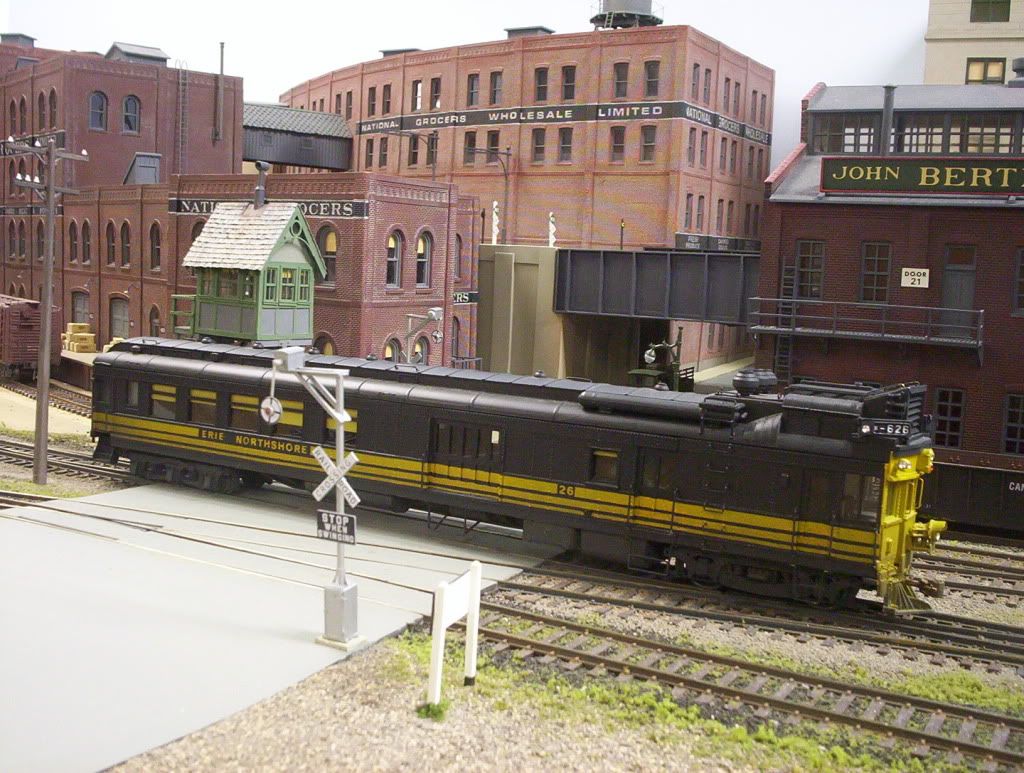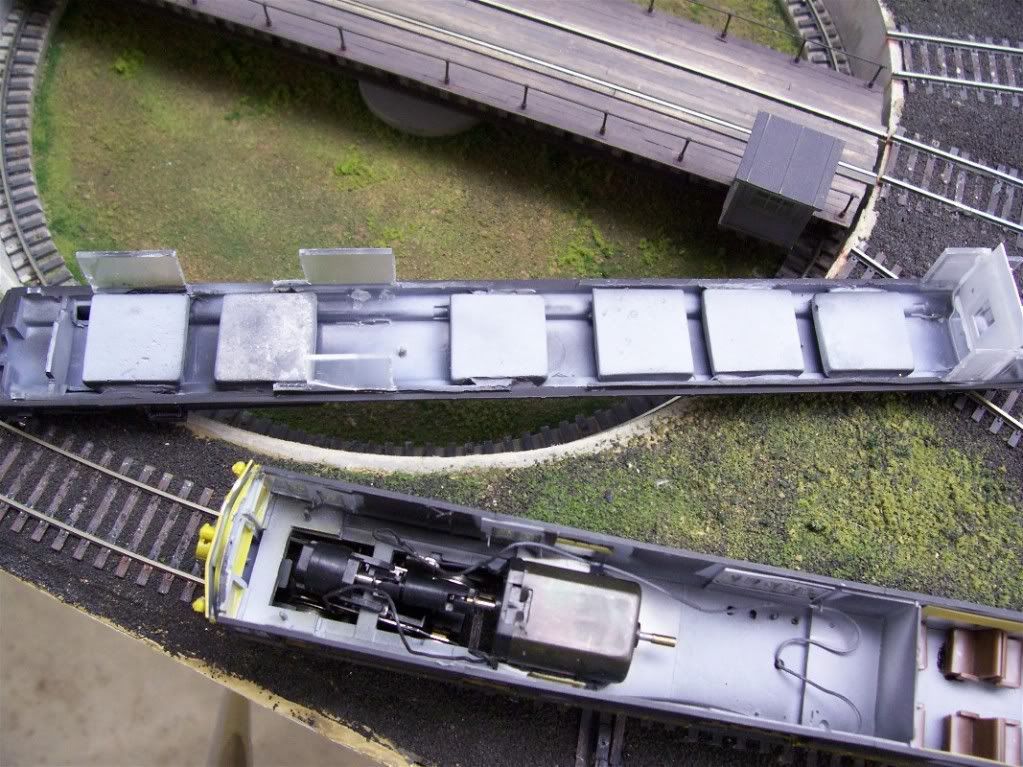if rolloing stock is weighted at .65 oz per inch, what is the optimal weight for engines and lococmotives?
That question has so many variables that it really is not possible to fully answer. I will try answer what I can.
Part of it depends on the quality of the motor that is installed in the engine. Some motors in the less expensive engines are such that any more weight will cause problems. As the engines get more expensive, they come with better motors capable of more control that can stand more weight but again on most of those they already have the correct amount of weight. If too much weight is put on an engine (from the amount of cars being pulled or the weight of the engine itself.) it will cause the wheels to spin and not be able to pull the needed load. (The spinning of wheels is why the prototype has to put multiple engines on a train and carry sand to gain traction when the track is slick. There are also times where the prototype has to double a hill or have a helper unit due to weight restrictions or pulling power.)
The weight also depends on the frame and the other materials of the engine. On some engines (Athearn as a example) the frames are metal, which adds weight to the engine, neagating the need for more weight. Other engines (some of the old Tycos, especially the GP20s, as an example) don’t have an underframe as such. The weight for them is in the solid metal trucks and plate weights in the middle of the engine. Some of the older engines (not that I have seen them in person) have the bodies made of metal which again affects the weight.
Another component is the type of engine itself. A little DDT type switcher doesn’t need a lot of pulling power as they only handle a few cars at max while a road engine has the capability to handle 20-30 cars at least.
As you can see, with the variety of engines and manufactureers, it is nearly impossible to have a standard for engines. On the other hand, freight cars, passenger cars and cabooses all have the same general design so it is much easier to have a weight standard for them.
The optimal weight for maximum pulling power is the maximum amount of weight the locomotive can hold and not exceed the rated amperage of the motor with the wheels slipping. That is, the weight added should not be able to stop the wheels from turning and stall the motor.
Even then one would not want to add weight such that the unit becomes top heavy.
As noted by the prior poster, one does not necessarily need a locomotive to have the maximum pulling power. Switch engines don’t necessarily need as much as a road loco, Passenger locos will often sacrifice pulling power for speed. Most layouts don’t need a loco to have maximum pulling power as they are too small. Or generally it is just easier to add a 2nd unit to the train.
EDIT EDIT what a big big typo - should NOT allow the wheels to stop turning.
I’m pretty sure that you meant to say “That is, the weight added should not be able to stop the wheels from turning and stall the motor.”
Most locomotives with good-quality motors can handle more weight than can be crammed into them. When I decided to add weight to my Athearn Mikados, I first tested them by draping a saddle of sheet lead over the boiler. The loco easily walked up a 2.5% grade with 22oz. of lead draped over its boiler, and yet, while I held the tender to prevent it from moving, readily slipped its drivers, indicating that the weight was not excessive.
Unfortunately, I was able to increase the weight of these locos by only 5oz. [banghead]
Unless one wishes to run their trains at excessive speeds, top heavy has little or no negative effect on a locomotive. I ballasted three Athearn U-Boats to 33.25oz apiece, much of that weight attached to the undersides of the hood roofs. They tracked flawlessly (and pulled pretty well, too). [swg]
The doodlebug shown below has most of its added weight in the clerestory…


…yet runs smoothly without tipping.
If one is adding weight to steam locomotives, the weight may be added anywhere that it’ll fit, but the loco should balance at the mid-po
Simple rule for weighting engines. More is better. I used to worry about too much weight would prevent wheel slip if the train should get snagged and prevented from moving. Not to worry. You cannot cram enough lead into an HO locomotive to prevent wheel slippage. Not enough room. Just ballast 'em up as much as will fit.
Clear back when John Page was MR’s Editor, he wrote a piece about locomotive weighting. It seemed that his maximum length train was twelve cars. Then, one day, he realized that a B&O 0-4-0T could pull it just as easily as his heavy power (a 2-8-0.) He decided to graduate the pulling power of his fleet - by removing weight. IIRC, he ended up with the Dockside downgraded to a maximum of five cars on level track, “With a little honest wheel spin if the engineer opened the throttle too quickly.”
So, it’s not a matter of a ‘standard’ weight, but what weight should give a specific loco appropriate pulling power on a specific layout. My comparatively light locos have to pull short trains on heavy grades. The power needs for a scale mile of grain hoppers on the Prairie Central would be entirely different, even though the locos might have the same length between coupler pulling faces.
Chuck (Modeling Central Japan in September, 1964 - where a 2-8-2 was heavy power)
Thank you Wayne, Yes that is what I meant. In all the editing of the message the “NOT” got dropped somehow. Normally I leave my mistakes in place, but that one is too big so I’ve edited the original message.
The optimal weight on my railroad is the least weight any car or loco/engine needs to operate and be reliable. Most cars have had weight removed and most steam engine tenders have also had weight removed. The engines still run well and pull more cars. On my railroad I feel the least amount of strain on the motive power is best.
As has been said multiple times, it depends on the locomotive and installed motor. You don’t want to add so much weight that it starts burning up decoders.
Weight can also have unforseen issues. I have a Bowser N1s (2-10-2) that pushes a beam bridge to it’s limits. On a 9in span, you can see the center sink 1/4in when it crosses